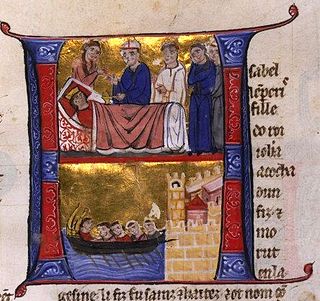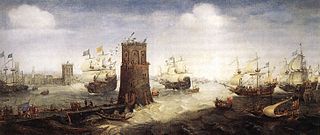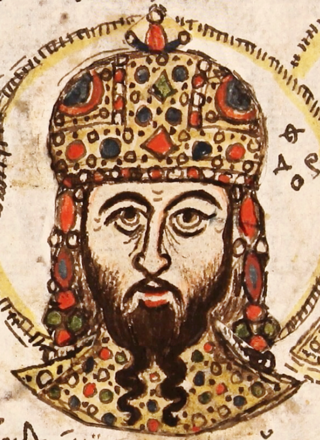
Aimery of Lusignan, erroneously referred to as Amalric in earlier scholarship, was the first king of Cyprus, reigning from 1196 to his death in 1205. He also reigned as the king of Jerusalem from his marriage to Queen Isabella I in 1197 to his death. He was a younger son of Hugh VIII of Lusignan, a nobleman in Poitou. After participating in a rebellion against Henry II of England in 1168, he went to the Holy Land and settled in the Kingdom of Jerusalem.

The Kingdom of Jerusalem, also known as the Crusader Kingdom, was one of the Crusader states established in the Levant immediately after the First Crusade. It lasted for almost two hundred years, from the accession of Godfrey of Bouillon in 1099 until the fall of Acre in 1291. Its history is divided into two periods with a brief interruption in its existence, beginning with its collapse after the siege of Jerusalem in 1187 and its restoration after the Third Crusade in 1192.

Year 1187 (MCLXXXVII) was a common year starting on Thursday of the Julian calendar.
The 1180s was a decade of the Julian Calendar which began on January 1, 1180, and ended on December 31, 1189.
The 1190s was a decade of the Julian calendar which began on January 1, 1190, and ended on December 31, 1199.

Year 1248 (MCCXLVIII) was a leap year starting on Wednesday of the Julian calendar.

Year 1221 (MCCXXI) was a common year starting on Friday of the Julian calendar.

Year 1227 (MCCXXVII) was a common year starting on Friday of the Julian calendar.

Year 1228 (MCCXXVIII) was a leap year starting on Saturday of the Julian calendar.
The 1240s was a decade of the Julian Calendar which began on January 1, 1240, and ended on December 31, 1249.

Year 1291 (MCCXCI) was a common year starting on Monday of the Julian calendar.

Year 1218 (MCCXVIII) was a common year starting on Monday of the Julian calendar.

Year 1219 (MCCXIX) was a common year starting on Tuesday of the Julian calendar.

Year 1190 (MCXC) was a common year starting on Monday of the Julian calendar.

Year 1239 (MCCXXXIX) was a common year starting on Saturday of the Julian calendar.

Year 1182 (MCLXXXII) was a common year starting on Friday of the Julian calendar.

Year 1244 (MCCXLIV) was a leap year starting on Friday of the Julian calendar.

Year 1249 (MCCXLIX) was a common year starting on Friday of the Julian calendar.

Year 1254 (MCCLIV) was a common year starting on Thursday of the Julian calendar.

The Sixth Crusade (1228–1229), also known as the Crusade of Frederick II, was a military expedition to recapture Jerusalem and the rest of the Holy Land. It began seven years after the failure of the Fifth Crusade and involved very little actual fighting. The diplomatic maneuvering of the Holy Roman Emperor and King of Sicily, Frederick II, resulted in the Kingdom of Jerusalem regaining some control over Jerusalem for much of the ensuing fifteen years as well as over other areas of the Holy Land.

















